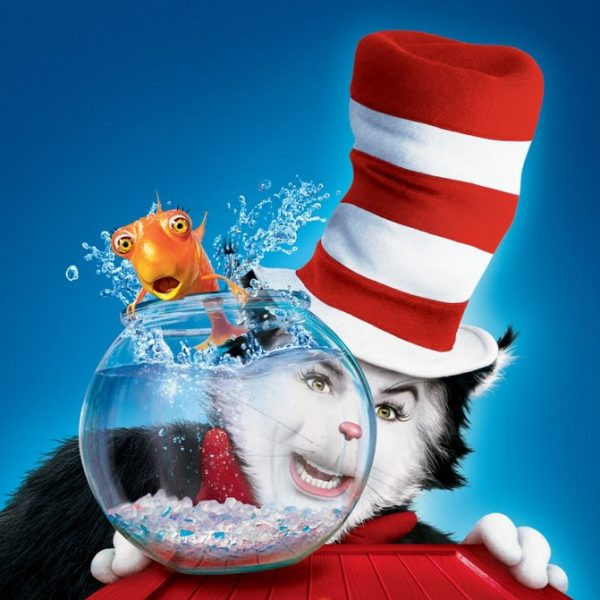The 2003 film adaptation of Dr. Seuss’ The Cat in the Hat, starring Mike Myers, is infamous for its abysmal 10% Rotten Tomatoes score. It swept the parody award circuits, securing ten Golden Raspberry nominations and a staggering twelve Stinkers Bad Movie Award nominations, even “honoring” child actor Spencer Breslin with an award named after him for worst child performance. The backlash was so intense that Dr. Seuss’s widow, Audrey Geisel, effectively banned any future live-action adaptations of her husband’s beloved works. Despite this critical drubbing and cultural exile, for some, including myself, this movie isn’t just watchable – it’s a comedic gem worthy of revisiting. In fact, I could probably quote large chunks of the script from memory, a testament to my enduring love for this misunderstood cinematic experience.
A Visually Arresting World: The Unmatched Set Design of Anville
Let’s be clear, my appreciation for The Cat in the Hat movie is entirely sincere. As a child, I watched the DVD countless times, each viewing as enjoyable and vibrant as the first. What immediately grabs your attention is the film’s spectacular and intensely colorful set design. Anville, the fictional suburban setting, is a masterclass in visual extravagance. Houses are uniformly yellow, cars are consistently green, and the city center explodes with purple sidewalks and comically oversized storefronts. The sheer level of detail in the set construction seems almost excessive for a movie ostensibly aimed at children. The intricate craftsmanship might be lost on younger viewers preoccupied with the zany antics, but the vibrant colors and outlandish shapes undeniably resonate, as they certainly did with me. The costume design is equally stylized and elaborate, drawing inspiration from mid-century American fashion, lending Anville a timeless quality. The film feels simultaneously contemporary and reminiscent of the 1950s, creating a unique and captivating visual landscape.
 Mike Myers as The Cat in the Hat, showcasing the vibrant and detailed costume design, standing in the meticulously crafted set of Anville.
Mike Myers as The Cat in the Hat, showcasing the vibrant and detailed costume design, standing in the meticulously crafted set of Anville.
Beyond “Painfully Unfunny”: Appreciating the Film’s Fast-Paced Comedy
Reading the avalanche of negative reviews for The Cat in the Hat movie, particularly the Stinkers nomination for “Most Painfully Unfunny Comedy,” serves as a stark reminder of comedy’s subjective nature. To label this film “painfully unfunny” is baffling considering its relentlessly fast-paced script and constant barrage of quotable one-liners. The dialogue ricochets between characters with an almost manic energy, as if they are barely keeping up with the comedic onslaught – a quality that, in my view, amplifies the humor. Packed with witty quips, rapid-fire references, and slapstick absurdity, The Cat in the Hat movie barrels along at breakneck speed, never becoming dull or tedious.
Mike Myers: The Embodiment of The Cat in the Hat
Growing up, I was particularly drawn to the bickering yet loving relationship between Sally and Conrad, the siblings whose mundane day is upended by the arrival of the eponymous Cat. Their sibling dynamic felt incredibly relatable, mirroring my own relationship with my sister. They seemed like genuine, well-developed characters, making the criticism leveled at Spencer Breslin’s performance as Conrad, culminating in a Stinkers Award named after him, seem particularly harsh. Both Breslin and Dakota Fanning (Sally) were unfairly nominated for these dubious accolades.
While Tim Allen was reportedly considered for the role of the Cat, it’s difficult to imagine anyone other than Mike Myers in the stripy hat. Myers completely embodies the role, throwing himself wholeheartedly into the demanding physicality, exaggerated movements, and quirky vocalizations of the hyperactive Cat. He leaves no comedic avenue unexplored in his pursuit of pure, unadulterated weirdness. In this regard, comparisons to another divisive Dr. Seuss live-action adaptation, How The Grinch Stole Christmas (2000), are inevitable. In that holiday staple, Jim Carrey similarly channeled the spirit of classic slapstick and irreverent comedy, resulting in a performance that, while iconic to some, was criticized by purists for straying too far from the source material.
Re-evaluating Seuss and Embracing Rebellious Adaptations
Leonard Maltin’s Movie Guide famously declared The Cat in the Hat movie “a betrayal of everything Dr. Seuss stood for.” However, in recent years, Dr. Seuss’s own legacy within children’s literature has undergone significant re-evaluation. His cartoons have faced accusations of racism, misogyny, and anti-Semitism, and his stories have been critiqued for containing racially insensitive imagery in modern contexts. Given this evolving perspective on Dr. Seuss himself, what exactly are the “purists” so vehemently defending?
Perhaps The Cat in the Hat movie‘s much-maligned departure from the source material is not a flaw, but a strength. This surreal, over-the-top comedy may be relegated to cinematic infamy by mainstream critics and award bodies, but for a dedicated group of fans, myself included, it endures as a rebellious, anti-establishment celebration of childhood fun. Its very rejection of the sanctity of the original book is what makes it a unique and, dare I say, classic piece of cult cinema.

